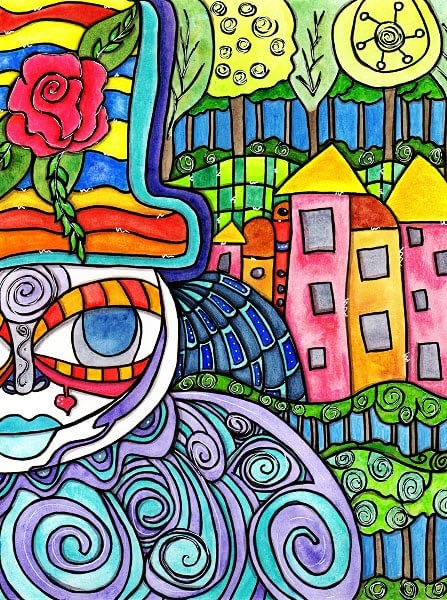One of the greatest achievements of Hundertwasser was his ability to evoke emotional connections between individuals and the built environment. Similarly, I aim to create art that resonates with the viewer on a profound level. By infusing my pieces with layers of bold lines, vibrant hues, and intricate details. I aspire to elicit an emotional response and forge a connection between the viewer and the artwork.
My journey continues with Hundertwasser’s inspiration and his belief that architecture should be in harmony with nature and man. Here are a couple of my latest pieces.
Hundertwasser embraced imperfection and believed that irregularities and asymmetry were essential components of beauty. In my latest pieces here, I have embraced this philosophy. Experimenting with unconventional shapes and organic forms. By embracing imperfections and embracing the unexpected, I strive to create art that reflects the beautiful complexities of life itself.
As my journey continues, I find myself endlessly inspired by Hundertwasser’s profound teachings. Through his vision of harmony between architecture, nature, and humanity, he has left an indelible mark on the art world. With each brushstroke, I seek to honor his legacy and contribute to the ongoing dialogue about the importance of sustainability, individuality, and emotional connection. Together, let us strive to create a world where art and architecture exist in perfect harmony with nature and man.
Remember to stay tuned for my upcoming creations, as I delve even further into the depths of inspiration that Hundertwasser has gifted us. Until then, keep embracing the beauty of imperfection and the magic of a harmonious existence.
Find Out More About Hundertwasser
Friedensreich Hundertwasser started out as a painter. Since the early 1950s, however, he increasingly became focused on architecture, writing, and reading in public .’ advocating natural forms of decay. In 1972, he had his first architectural models made for the TV show‘ Wünsch dir was’, in order to demonstrate his ideas on forested roofs, “tree tenants” and the “window right” of every tenant to embellish the facade around his windows. In these models, Hundertwasser also developed new architectural shapes, such as the “eye-slit” house and the “high-rise meadow house”.[1] ~source Wikipedia







